Q & A With TIMOTHY ARCHIBALD
Timothy Archibald, an advertising and editorial photographer, is the first of my interviewees who was ‘tagged’ by a prior interviewee. This is a new feature on the blog in which I ask an interviewee to tag someone else to be interviewed. Shannon Amos (Q&A forthcoming) recommended I talk with Timothy Archibald about his ECHOLILIA project, a book he produced in collaboration with his son who has been diagnosed with Autism Spectrum Disorder. I was familiar with this project and with his commercial work so was very excited at the prospect of an interview.
Timothy agreed and I started reading everything that had previously been written about ECHOLILIA. At first, my fear was that a lot of ground had been covered and that I might not have a lot to add to the dialogue, that it had all been said. But after reading all the interviews, I realized I still had more questions. And most importantly, that with any really powerful body of work, there is depth and resonance and a relationship to be built with the work.
This interview is the result of many hours spent looking at these haunting images of a beautiful child in often curious and poetic poses, reading prior interviews and thinking about growing up with my own brother who was given a label that identified him as ‘different’ and sent him to school on a little yellow bus, isolated him and created a split in myself and others who didn’t know how to relate to or therefore include him in our ‘normal’ lives. I like to think that this beautiful series of photos has added a note of understanding and tolerance to the world and has helped inch our humanity forward in the way that only art can.
All photos are from the book ECHOLILIA with the exception of the photo of Timothy Archibald which was taken by his son Eli during the process of creating the images for this project.
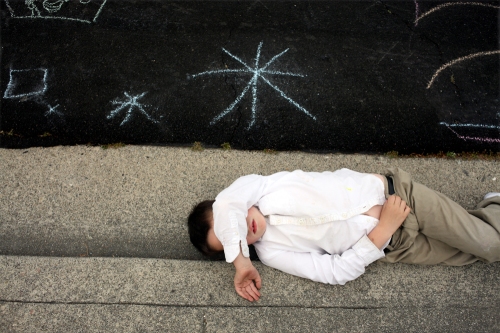
For the full interview, please click below.
POP: Why ECHOLILIA?
For me, I wanted a title that people would approach without any previous baggage…something no one would know what it meant, but they could kind of figure it out by the sound. My word, ECHOLILIA, sounded like “echo” and sounded like a pretty flower “lily” and those two things summed it up for me. In medical books about Autism, the word “echolailia” appears, which refers to this type of verbatim copying of sounds and sentences. I liked the actual meaning because it reminded me of what I was doing: copying my kid, copying his stuff, photography is like copying something…it could go on and on. And I liked the meaning one would guess at, even if they didn’t know what it meant.
POP: How did you decide to not simply photograph your son as a subject, but to engage him as a full collaborator in the process? You wrote in a previous interview that at first the shots with your son were very short, just a few minutes, but that over time the shoots would take 45 minutes with Eli fine-tuning poses and helping to set up the camera and load film. Did the thought to involve him in the process evolve with the project or was that your original intention?
In photography there always has been this uneasy relationship between the subject and the photographer. One has the power, one kind of is the victim…or something like that. My previous big project was very anthropological (Sex Machines : Photographs & Interviews, 2005 ), it was essentially a documentary project looking at the inventors of home made sexual machinery….made up of photographs and interviews with the subjects. I wanted to give these people a voice, you know…let them tell their story in their words. We had book readings and art openings and got the people in the book to attend and meet the audience. I really loved the experience because I felt it took away a bit of the sting of the photographer being the decision maker…the photographer being on one side and the subject being on the other side. But still…it made me uneasy. I still felt like it was me showing everyone how clever and observant I could be, and maybe I was just using these people in the book to allow me to show off. Or was I really giving them a voice? There is no answer, but the questions will forever be out there. The truth is probably somewhere in between. But this is like the dilemma with the documentary tradition in photography.

Starting this project, I did have it in mind that the thing could just be richer if I could get inside my son’s head and let that unique way in the world steer the photographs. So…to get the good photographs, to get inside his head, we needed his voice and take on things. And really, you can’t make a kid pose endlessly for photographs…they need to get something out of it. This is what he wanted to do—he wanted to make the photographs with me. And when it was clear he wanted that…I kinda embraced it, because it helped deal with that dilemma. It wasn’t just me looking at him, it was now us looking and creating together.
POP: Did your son take any photos of you or with the two of you in the image together?
We have a lot of images of me taken by Eli. I’d pose, he’d shoot. A lot of times we’d take turns. I’d have my shot, he’d have his. He does have the ability to make people look great…I think its just dis-arming to be photographed by a 7 year old with a Hassleblad on a tripod. But he also is more into shooting a scene, an object, things in his every day life…his sock on a bed…that type of thing. The kind of role playing that goes on in ECHOLILIA isn’t really the way he’d shoot something. And I’m saying none of this with irony- the entry point for photography now, with digital cameras, could really be any age. Operating the thing is easy, the visual literacy is still the thing that needs to be learned, but it can be learned at a pretty young age.
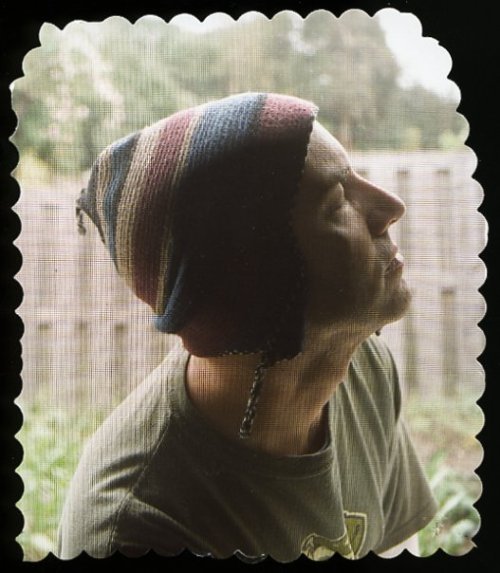
POP: On some level, the subject is always a collaborator. But with ECHOLILIA, you co-directed the shots and you undertook the project to learn about your son and build a deeper relationship with him. You’ve written that this helped to build a bridge that wasn’t previously there. How did the process enable this and what did you learn about your son and yourself that helped to create this deeper connection?
I guess we should back up a bit. I didn’t undertake the project to build a deeper relationship with him…that’s just what happened. I began the project to really just use whatever tools I have to make sense of this kid I couldn’t really make sense of. It was for me: a selfish endeavor. I wanted the help. I wanted to use the tools for me! But like lots of things that start out selfishly, they end up being good for others too and good things grew from it.
But more functionally, when I saw the images we could create together—with his input, that’s when it got exciting. It didn’t look like my photographs…it looked better and more fascinating and had this “shock of the new”. And me, being the greedy photographer, wanted more of them. Who wouldn’t want fascinating photographs?

But…that said, what did we learn? I think it was an internal change…something you can’t really quantify, but you know it when you feel it and use it in your day-to-day living. On the most superficial level, we created a shared visual vocabulary. But deeper than that, I think we learned what made each other tick.
POP: What insights did you gain into his way of thinking and seeing or experiencing the world?
Well….there is a system of logic that seems to govern things…like Spock on Star Trek. Logic, systems, grids, structures seem to guide his way of thinking…but none of this is apparent in the photographs. I think really the best answer to that is in the images. This little world or emotion or tone they have, the channel they are on…that’s my attempt to share maybe his channel, or what its like to try to tune into that channel from my outside position. I’m not him, but I’m trying to get in there. That attempt, that action, gives the photographs their language.

POP: Are there other ways in which you and your son now relate that were made possible by this project?
I dunno…but things are better. There isn’t this great divide anymore. There isn’t this mystery. For now we have this understanding I think…and really it allowed us to end the project. The code we wanted to crack got figured out, so now we don’t need to make these photographs anymore! Or at least that’s what it feels like.
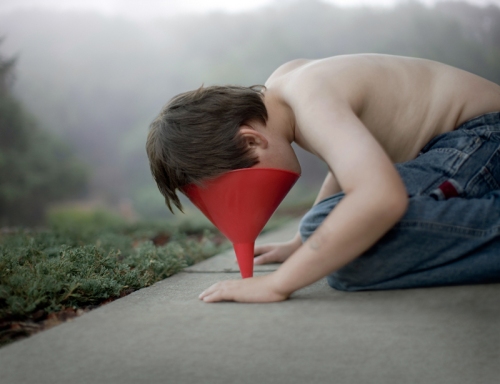
Last week we had this great experience. A national magazine approached Eli and I about shooting a series about children’s mental health. I’d shoot, Eli would be the subject, and we’d work with the magazine on the concepts, all shot in our home. It was an experience I’ll really never forget. But one thing was clear—it felt a little like William Wegman arranging the dogs. We could indeed make these photographs and make them look intense, but we didn’t NEED to make the photographs, we were more mechanical…it was work. When we were doing ECHOLILIA, we had the need. That was the difference.
POP: Has this project changed what you think about the power of standard portrait photography to create resonance and connection?
Hmmm. People are resonating with these images and they are getting attention, but some of the impact is lost on me. It’s my kid, something we did together for other reasons, we liked them, then we started to share them. It was kind of a closed system I was letting people into. I think some of the wow factor with the images is that people feel like they are getting a glimpse into a father/son relationship that has layers of complexity to it. Which they are…but that’s not really standard portraiture, where one person looks at another person. This is kinda affecting to people because its got the relationship there.
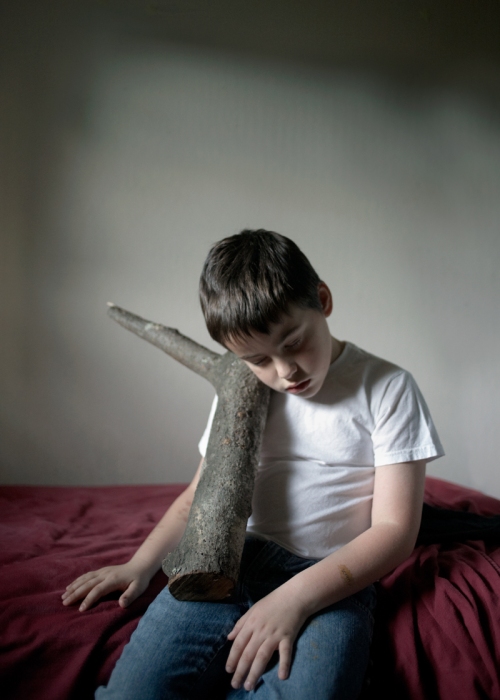
POP: Can you talk about the editing process? What was your criteria for which shots to include in the final book?
We had a lot of work. Access was always there, home was the setting, so it was easy to be prolific. You didn’t need to fly to the Soviet Union or something. There were some shots I always liked that didn’t fit into the book. I needed it to have some sort of beginning, middle, and end. The book kind of has that, but it’s not literal…more just the way the pairs present themselves to the viewer, the pacing, what works with the text, what works with the pairs, the singles. All those book things I like to geek out about came into play.

POP: I also keep thinking about how the photos themselves contain the beauty of the overall project, that the non-traditional poses contain a depth of emotion and heart that draws the viewer in, that the humanity is sometimes privileged over a traditional sense of composition, yet they are deeply powerful images because of this. What’s interesting to me is that children with ASD are often considered to lack affect or emotion, but these images are full of feeling. Did you discover a deeper level of feeling in your son with these images and did you come away from this feeling that the ASD label is confining or limiting with regards to this?
Wow…lots to think about. I think the stuff that gives the images some perceived emotion is like…the father/son love. It’s not about the subject lacking a full range of emotions or expressions, it’s about the relationship having the range. So, the relationship has the full range of emotions, and Eli and I were able to make images that share that.
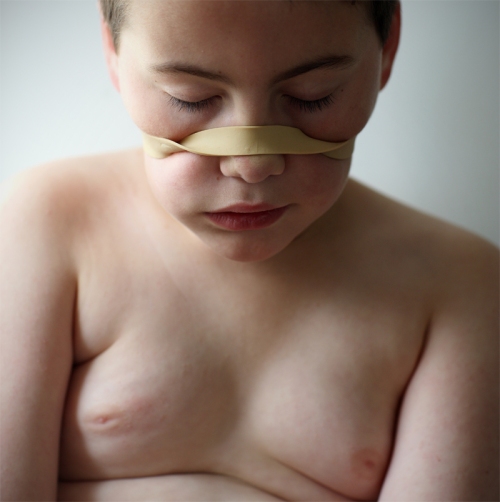
As far as the ASD label…oh…I don’t really know. I feel like its such a broad spectrum that its hard to really say it’s always one way or the other. I know for me, I always thought ASD meant the kid couldn’t communicate…primarily because I saw a tv show about it in the 80’s. So…I didn’t really have the info. But again, I always try to clarify that Eli has a big vocabulary and goes to public school and all of those things. But he is tuned a bit differently.
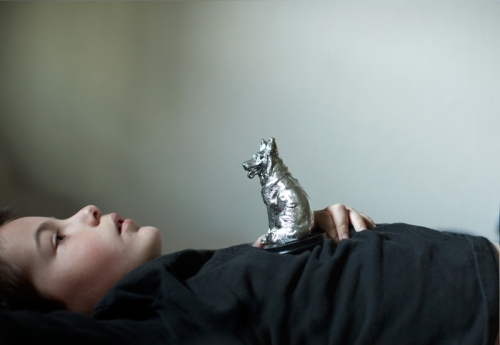
Did this project change the way you relate to/with your editorial and commercial subjects?
Yes…for sure. With this project it seems like it’s all about the emotion…all about the connection. The photographs aren’t really well constructed. Some of them are like “feral photographs”…or something that works more instinctually. I find myself trying to kind of offer up that emotional stuff to clients when it’s possible, mostly because I think I’ve learned how to tap into it. But really, you need the right project for that…and those projects are really special when they come around. Fortunately I’m working on one now, and its no question that the rawness of ECHOLILIA helped us get this job.

POP: You’ve said that you don’t necessarily buy into or agree with the ASD diagnosis, but that your son is ‘tuned differently.’ How did this project affect your perspective?
Oh, I’m always the one running around wondering if really it was all a mistake. You know your child so well, you just accept him as he is. Then you go out of town for a while, come back…and it hits you strongly again….all the differences and things that make up that channel. But every year I ask his teacher if she is aware of something different about him…and every year they say “yep.”
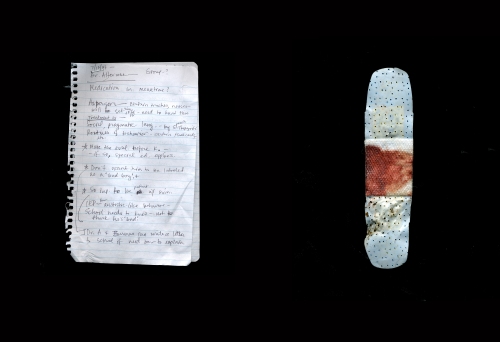
POP: I’m interested in the idea of inclusion in your work. With regards to your previous work, you’ve said you like to include people’s surroundings in their portraits. This is a bit different, but seems related, not to leave anything out or to give a complete picture of something or someone. As a culture, we are programmed to create difference and separation. And people who are different for any reason are often marginalized and excluded and therefore unknown in many ways and this of course leads to fear, ignorance and intolerance.
One of the things I find so moving about ECHOLILIA is that it not only depicts, but looks deeply and builds relationship with something we label as ‘different.’ And this level of engagement and the palpable tenderness in the photos succeeds in creating a real relationship between the viewer and something we might not have access to otherwise.
Is this something that you consider to inform your work? (fine art)
Funny you should mention that. With my previous project, Sex Machines, I thought its’ thesis was kind of to show these people who society would traditionally think were social misfits, and show the reader how normal and human and likeable they were. Like…trying to be counter intuitive, and get to the humanity by just digging deeper and getting to know the people. So with that project, I was really trying to do that—like celebrate and embrace the marginalized.
One day I had caught up with a friend from high school…someone I hadn’t spoke to in twenty years. Catching up, I tell her about my kids, what’s up with Eli, and the project we were doing. Her response was “ Well…you always seemed to be attracted to that which was different.” That response really rang true to me. She painted me accurately there.
With ECHOLILIA…there wasn’t any real thesis. It was just life…you know, shooting images with your kid, trying to make sense of stuff, trying to spend time together, trying to answer some personal question we never really stated. You work and work and next thing you know you have a body of work and it starts to have some power. So this project never had a thesis…but it did have a channel we wanted to be on, and that seemed to carry it through and instill it with these layers. Then…its up to the viewers to take in and decide what they get from it.
A huge thank you to Timothy for the time and attention he gave this interview. It was such a pleasure to spend time with his work.
Purchase ECHOLILIA here.
More interviews here.
Filed under: advertising photographer interview, editorial photographer interview, photographer interview | 3 Comments
Tags: autism spectrum disorder, echolilia, San Francisco advertising photographer, San Francisco Editorial Photographer, timothy archibald
Enjoyed reading this.
Huge fan. Beautiful work Timothy.